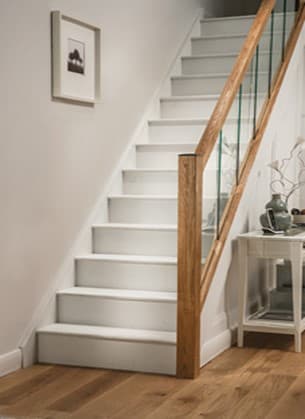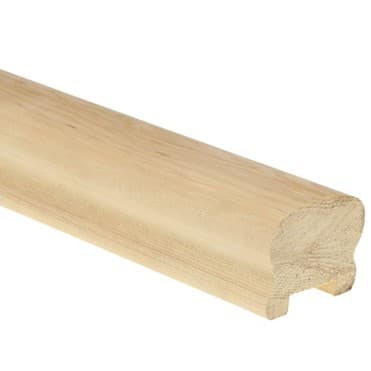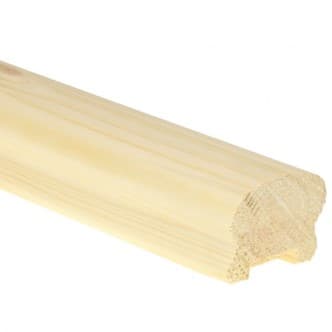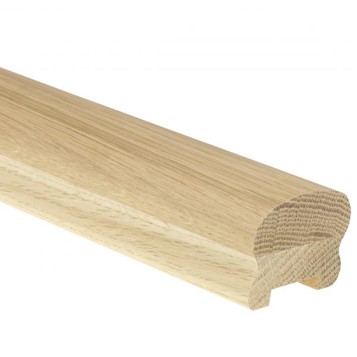What are grooved handrails used for? | A guide to the types of grooved handrails
There are two main types of handrails available for your staircase - grooved and ungrooved. Grooved handrails are designed to be fully integrated on top of spindles, or glass panels. Ungrooved handrails, on the other hand, are designed to be fitted to metal or wooden spindles, or to glass panels via brackets and clamps. When designing your staircase, your choice between grooved and ungrooved handrails will depend on the materials you want to use and the size of your spindles or glass panels.
In this article, we go into more detail on the potential uses for grooved and ungrooved handrails. We also help you to choose the right style handrail for your staircase, and outline the different types of grooved handrails we have available.
Click on a link to jump to each section:
Read the different uses for grooved handrails.
Find out more about how non-grooved handrails can be used.
Read our guide to choosing the right size handrail groove.
Find out what to consider when choosing the right grooved handrail for your staircase.
Read our guide on caring for wooden handrails.
What are the different uses for grooved handrails?
Glass grooved handrails are designed to be used alongside glass panels. They have a narrow, deep channel running along the full length of the handrail into which the glass panel slots. Usually, clear silicone is used to help secure the glass in place. The grooved handrail eliminates the need for any metal brackets to connect the glass panels to the handrail. Many people like the contemporary appearance of seamless, uninterrupted glass panels which create a sense of bright airiness.

An example of glass grooved handrails being used to house glass panels. (Jackson Woodturners - Stair Parts Range Brochure page 14).
Using glass panels in your staircase creates an ultra-modern and sleek design that looks right at home in contemporary properties or creates a bold statement in more-traditional environments.
Grooved handrails with wide, shallow channels are designed to be used primarily with wooden spindles. The groove must be the same width as the spindles you intend to use to achieve a secure fit. The groove runs along the full length of the handrail so that spindles can be spaced as often as necessary. Timber infill, also known as spacer or filler, is normally provided with these types of grooved handrails. It is worth noting that although Jackson Woodturner's handrails and base rails will come with infill, you will need to buy silicone separately.
Metal spindles can also be connected to grooved handrails designed for metal, which have a smaller groove.
Our 32mm and 41mm grooved handrails are designed to be used with 32mm or 41mm spindles. The overall size of these handrails is the same, but the measurement refers to the width of the groove which should match the width of your chosen spindles. They're available in a range of different wood varieties to match your other chosen wooden stair parts.
Hemlock Cottage Loaf Handrail - 41mm Groove with Infill

-
Hemlock stair parts are supplied unfinished. They can be left as is, for a natural finish, but we do recommend finishing them by either painting, varnishing or waxing for an enhanced look, that will also help to protect.
-
Handrail Dimensions: 66mm x 45mm, with 41mm groove and infill
-
Available in 1800mm, 2400mm, 3600mm and 4200mm lengths.
Using non-grooved handrails
Ungrooved handrails are designed to be used alongside metal spindles. The spindles are attached directly to the handrail, so there is no need for a groove. When using metal spindles with ungrooved handrails, a spindle foot can screw directly into the rail.
You can also use non-grooved handrails with glass panels, provided that the panels are designed to be suitable for this type of handrail. The panels should have holes drilled into them where stainless steel brackets can be attached to fix the panels directly to the handrail. Our Fusion and Clarity ranges of glass stair parts are both suitable for use with ungrooved handrails.
Mopstick handrails are also an example of ungrooved handrails, but these are usually designed to be attached directly to the wall rather than to form a balustrade.
How do you choose the right size groove?
If using a grooved handrail with glass panels, check the width of the glass panels and look for a handrail with a groove of the same depth. For example, our 8mm grooved handrails are compatible with the following glass panels, which are 8mm thick:
Our Immix glass panels are also 8mm thick, but they should only be used with other Immix stair parts to ensure a secure fit and unified finish. You should therefore choose one of our Immix Oak Handrails which are available in 2.4m, 3.6m and 4.2m.
When using grooved handrails with wooden spindles, check the width of your spindles and choose a handrail with a groove of the same width. Our 32mm grooved handrails fit all of our 32mm spindles, including the Forge range of brushed nickel spindles. Our 41mm grooved handrails are compatible with our 41mm wooden spindles.
Choosing the right grooved handrail
In addition to size, you'll also want to consider style, material and price when choosing the right grooved handrail.
All of our 8mm glass grooved handrails have a simple and modern square design with a curved top. They match the clean, contemporary feel of glass staircases well. Our 32mm and 41mm grooved handrails for wooden spindles are also available with this modern square design, or you could choose HR or Cottage Loaf designs which are more traditional and can give your balustrade a classic and somewhat ornate finish.
Grooved handrails are available in a wide range of wood varieties to suit your tastes and preferences. Lighter shades of wood such as pine, ash and hemlock can help to brighten up a dark or dull hallway. Darker colours like walnut and dark hardwood can create a more dramatic staircase. White primed handrails are a handy choice if you plan to paint your stair handrail a solid colour rather than waxing or varnishing.
Softwoods such as pine and hemlock are more susceptible to scratching than hardwoods like oak, walnut and ash. However, softwoods can be painted more easily so they may be a better choice if you plan to paint your handrail.
The Pine Cottage Loaf Handrail - 32mm Groove with Infill

-
The Pine Cottage Loaf Handrail - 32mm Groove with Infill is from our great range of quality pine stair parts.
-
The cottage loaf handrail is designed with a 32mm groove, which allows all 32mm spindles to be fitted into the groove. A length of infill/spacer comes pre-packed in with the product at the same length as the handrail.
-
Pine stair parts are supplied unfinished. They can be left plain, for a natural finish, but we recommend finishing them by either painting, varnishing or waxing for an enhanced look and to help protect them for longer.
-
Handrail dimensions: 66mm x 45mm, with 32mm groove with infill.
-
Available in 1200mm, 1800mm, 2400mm, 3600mm and 4200mm lengths.
When it comes to price, pine, hemlock and white primed handrails are more affordable than oak, ash and walnut. If you love the traditional look of walnut you could consider a dark hardwood handrail instead, which is more affordable and imitates the rich, deep hue of walnut. However, if durability and strength are your priorities when looking for a handrail – we recommend investing more in an oak grooved handrail.
Oak Cottage Loaf Handrail - 32mm groove with infill

-
The Oak Cottage Loaf Handrail - 32mm groove with infill is from our superb range of high-quality white oak stair parts.
-
The HR handrail is designed with a 32mm groove, which allows all 32mm spindles to be fitted into the groove. A length of infill/spacer comes pre-packed in with the product at the same length as the handrail.
-
Oak stair parts are supplied unfinished. They can be left as is, for a natural finish, but we do recommend finishing them. They can be finished by either painting, varnishing or waxing for an enhanced look, that will also help to protect.
-
Handrail Dimensions: 66mm x 45mm, with 32mm Groove & Infill
-
Available in 1800mm, 2400mm, 3600mm and 4200mm lengths.
Caring for your grooved handrails
Since our grooved handrails are all made from wood, they can be cleaned and maintained fairly easily. The handrails are provided unfinished so that you can wax, varnish or paint them to your liking. Once finished, they can simply be polished with suitable wooden furniture polish and a microfibre cloth to remove dust and dirt.
Wooden stair parts such as handrails may require periodic refinishing overtime to keep them looking their best. Applying a fresh coat of wax may be enough if you chose to simply treat the wood with wax during installation. If you varnished or painted the handrail, you may have to sand it down before repainting or revarnishing. Check out our guide on finishing spindles for woodcare advice that can be applied to your handrails.
If you choose one of our white primed grooved handrails, it's important to note that these are designed to be painted with a suitable solvent-based topcoat. This should be done as soon as possible to protect the wood. Painted handrails can usually be simply polished or cleaned with a very mild detergent, but it's important to check the care guidelines of your chosen paint topcoat.





